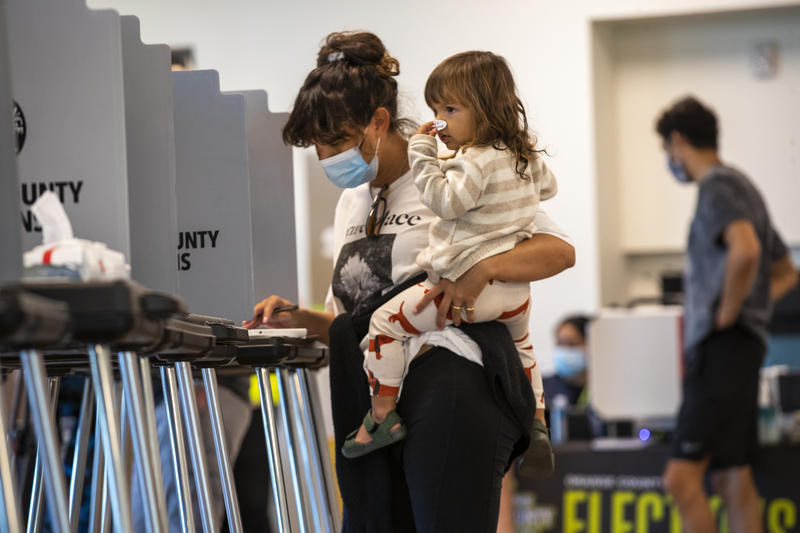
Billie Montague, 2, puts a vote sticker on her nose while watching her mom, Ashley Montague, vote in Newport Beach in 2020.
Credit: Allen J. Schaben/Los Angeles Times/Polaris
Children are not merely passive recipients of voting outcomes; they are capable participants in building a future shaped by informed civic values and active community involvement. We must foster responsible use of their civic knowledge and power for a better future.
Introducing children to voting from an early age — as young as 5 or 6 — can instill in them a sense of civic responsibility, sparking curiosity about how individual actions influence the broader community, and shaping informed, engaged citizens for the future.
In my work on diversity, equity and inclusion, I spend much time thinking about misinformation, access barriers and participation roadblocks.
Voting processes are vulnerable to misinformation tactics aimed at suppressing marginalized voters, including Black, Latino, disabled, rural residents, and the elderly. Voting with children is no exception to this insidious campaign to bar access and participation for every eligible voter. Child care access issues can even act as an indirect form of voter suppression. When parents, particularly single parents or those in underserved areas, are unable to find or afford child care, voting in person may become challenging or impossible. These barriers are compounded in areas with limited polling locations, long wait times, or fewer resources for early or mail-in voting, which are essential accommodations for parents who may otherwise be prevented from casting their vote due to lack of child care. Even when voting accommodations — voting by mail or surrendering early ballots at polling places — are available, misinformation around these options can impact parents’ ability to participate.
Every Californian must be well-informed about the Voter Bill of Rights. We are fortunate to reside in a state that actively implements legislation to enhance accessibility and participation for voters, including future voters. An example is the provision allowing California teens aged 16 and 17 to preregister online, with automatic registration upon turning 18.
Recognizing the significance of civic engagement among Gen Z (the youngest of whom are 12 years old), it’s noteworthy that they exhibit higher voting rates than previous generations. In 2024, a staggering 41 million Gen Z youth are eligible to vote, with millions more set to join the electorate by 2028.
Efforts to expand access and participation are crucial because civic engagement, including voting, is essential and has widespread impact. Ultimately, it’s a fundamental right that touches each of us deeply; it’s the sole avenue for every citizen to participate in the democratic process.
Political socialization is how people learn about politics, form beliefs and understand their civic role. While parents typically pass political views to their children, research shows influence can also go the other way: Children’s awareness of civic issues can shape their parents’ views, a process known as “trickle-up socialization.” As children engage with topics affecting their communities — through school, social media, and peers — they may prompt discussions that lead parents to consider new perspectives. Bringing children to the voting booth reinforces this process, offering them hands-on exposure to democracy, sparking meaningful questions, and fostering family engagement, especially in marginalized communities where awareness and representation are vital.
However, it’s concerning that American knowledge of civic engagement has declined, with significant gaps in understanding fundamental aspects of government and constitutional rights, as revealed by the Annenberg study released annually on Citizenship Day. The study noted 1 in 3 Americans cannot name the three branches of government, and less than a third can name the rights guaranteed by the First Amendment beyond freedom of speech.
As parents, we can inspire an informed and engaged generation of citizens. If you haven’t made a family voting plan for the Nov. 5 election, there’s still time to register and participate together. Preparation is critical; here are practical considerations for voting with children in California:
Voting with kids in the November presidential election is not only allowed but purposeful, serving as a primer for future elections and instilling democratic values early on.
•••
Amira K.S. Barger, MBA, CVA, CFRE, is a diversity, equity and inclusion consultant and a professor at California State University, East Bay.
The opinions expressed in this commentary represent those of the author. EdSource welcomes commentaries representing diverse points of view. If you would like to submit a commentary, please review our guidelines and contact us.

